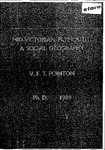MID-VICTORIAN PLYMOUTH: A SOCIAL GEOGRAPHY
| dc.contributor.author | Pointon, Vivien Frances Turner | |
| dc.contributor.other | School of Geography, Earth and Environmental Sciences | en_US |
| dc.date.accessioned | 2012-08-02T16:19:55Z | |
| dc.date.available | 2012-08-02T16:19:55Z | |
| dc.date.issued | 1989 | |
| dc.identifier | Not available | en_US |
| dc.identifier.uri | http://hdl.handle.net/10026.1/1099 | |
| dc.description.abstract |
In the 19th century, the two settlements of Plymouth and East Stonehouse grew and coalesced into one urban area. Natural population increase and immigration both contributed to the rapid population growth which gave impetus to the urban expansion. Analysis of the unpublished census manuscripts for I85I and I87I revealed clear patterns of distrihution indicating segregation according to demographic, occupational and birthplace characteristics. There was severe overcrowding, population density was higher than that of mid-Victorian London and Liverpool, and the consequences for local public health and on the morphology of the urban area were substantial. Deprivation and poverty occurred not only in the older, cramped parts of Plymouth but also i n newly-built housing areas, such was the demand for accommodation. This provided an impetus for suburbanisation. Mid-Victorian Plymouth was a thriving, cosmopolitan trading port with a large fishing fleet and it was an important military and naval base. The town also served southwest Devon and southeast Cornwall as a market for local goods and produce. The local economy supported a wide-ranging employment structure, responding to infrastructural improvements, and provided a magnet for immigrants primarily from rural Devon and Cornwall but also from many other parts of Britain and from Ireland. Women formed a greater than average section of the local population, the towns attracted country girls to work as domestic servants and, also, many women were temporarily deserted as their husbands' occupations took them away from home. Principal component analyses show that, following a rapid phase of population growth i n the 1840s and 1850s, the combined population of Plymouth and Stonehouse entered a period of slower growth when immigration gave way to natural increase. The later phase is identified as a time of consolidation as immigrants settled and the local economy prospered, the population became more integrated and homogeneous. | en_US |
| dc.language.iso | en | en_US |
| dc.publisher | University of Plymouth | en_US |
| dc.title | MID-VICTORIAN PLYMOUTH: A SOCIAL GEOGRAPHY | en_US |
| dc.type | Thesis | |
| dc.identifier.doi | http://dx.doi.org/10.24382/3726 | |
| dc.identifier.doi | http://dx.doi.org/10.24382/3726 |
Files in this item
This item appears in the following Collection(s)
-
01 Research Theses Main Collection
Research Theses Main


